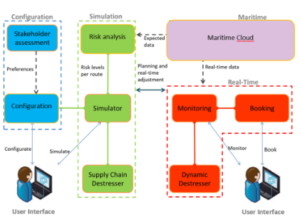 The objective of WP5 is to enhance all the necessary components developed in WP4 and integrate them in a single network. Within the structure of WP5, the aim of Task 5.4 is to create a seamless integration of all the modules developed in WP4 into a network-collaborative open eco-net, ensuring that all the aspects of the supply chain are interconnected with feed-forward and feedback interactive loops using SYNCHRO-NET open messaging protocols (developed in WP2). The developed eco-NET will span and traverse different business ecosystems belonging to stakeholders along the involved supply chains, resulting in a truly collaborative open network. Considering the overall structure of the service layer (in the following figure), it emerges that the Simulation module plays a central role in the SYNCHRO-NET network, being connected with all the other modules. In particular, the interaction between the Simulation and the Real-Time modules allows the final user to plan a shipment keeping into account a set of different Key Performance Indicators (KPIs) and Key Risk Indicators (KRIs).
The objective of WP5 is to enhance all the necessary components developed in WP4 and integrate them in a single network. Within the structure of WP5, the aim of Task 5.4 is to create a seamless integration of all the modules developed in WP4 into a network-collaborative open eco-net, ensuring that all the aspects of the supply chain are interconnected with feed-forward and feedback interactive loops using SYNCHRO-NET open messaging protocols (developed in WP2). The developed eco-NET will span and traverse different business ecosystems belonging to stakeholders along the involved supply chains, resulting in a truly collaborative open network. Considering the overall structure of the service layer (in the following figure), it emerges that the Simulation module plays a central role in the SYNCHRO-NET network, being connected with all the other modules. In particular, the interaction between the Simulation and the Real-Time modules allows the final user to plan a shipment keeping into account a set of different Key Performance Indicators (KPIs) and Key Risk Indicators (KRIs).
The data flow between these modules is as follows:
Module through a user interface, specifying the details of the route.
2) The Real-Time Module sends the request to the Simulator.
3) The Simulator provides a set of proposed routes and calculates the KPIs and KRIs for each route.
4) The set of potential routes, with KPIs and KRIs, is sent to the Real-time Synchro- modal Module.
5) Once the final user chooses his best transport solution, this solution is stored in a Historical Storage database in order to be used for future transport needs, allowing the system to learn from the past.
Source: Synchronet Staff